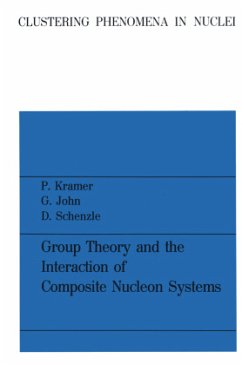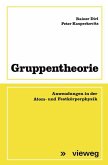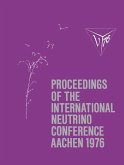Peter Kramer
Group Theory and the Interaction of Composite Nucleon Systems
Peter Kramer
Group Theory and the Interaction of Composite Nucleon Systems
- Broschiertes Buch
- Merkliste
- Auf die Merkliste
- Bewerten Bewerten
- Teilen
- Produkt teilen
- Produkterinnerung
- Produkterinnerung
The study which fonns the second volume of this series deals with the interplay of groups and composite particle theory in nuclei. Three main branches of ideas are de veloped and linked with composite particle theory: the pennutational structure of the nuclear fermion system, the classification scheme based on the orbital partition and the associated supennuitiplets, and the representation in state space of geometric trans fonnations in classical phase space. One of the authors (p. K.) had the opportunity to present some of the ideas under lying this work at the 15th Solvay Conference on…mehr
Andere Kunden interessierten sich auch für
![Independence Theory in Combinatorics Independence Theory in Combinatorics]() V. BryantIndependence Theory in Combinatorics42,99 €
V. BryantIndependence Theory in Combinatorics42,99 €![Sets and Mappings Sets and Mappings]() T. S. BlythSets and Mappings42,99 €
T. S. BlythSets and Mappings42,99 €![Extension and Interpolation of Linear Operators and Matrix Functions Extension and Interpolation of Linear Operators and Matrix Functions]() Israel C. GohbergExtension and Interpolation of Linear Operators and Matrix Functions42,99 €
Israel C. GohbergExtension and Interpolation of Linear Operators and Matrix Functions42,99 €![Wunder der Welt in farbigen Grafiken Wunder der Welt in farbigen Grafiken]() Iris GottliebWunder der Welt in farbigen Grafiken9,99 €
Iris GottliebWunder der Welt in farbigen Grafiken9,99 €![Gruppentheorie Gruppentheorie]() Rainer DirlGruppentheorie54,99 €
Rainer DirlGruppentheorie54,99 €![Proceedings of the International Neutrino Conference Aachen 1976 Proceedings of the International Neutrino Conference Aachen 1976]() Proceedings of the International Neutrino Conference Aachen 197654,99 €
Proceedings of the International Neutrino Conference Aachen 197654,99 €![Vom Haushalt der Zelle Vom Haushalt der Zelle]() John A. V. ButlerVom Haushalt der Zelle54,99 €
John A. V. ButlerVom Haushalt der Zelle54,99 €-
-
-
The study which fonns the second volume of this series deals with the interplay of groups and composite particle theory in nuclei. Three main branches of ideas are de veloped and linked with composite particle theory: the pennutational structure of the nuclear fermion system, the classification scheme based on the orbital partition and the associated supennuitiplets, and the representation in state space of geometric trans fonnations in classical phase space. One of the authors (p. K.) had the opportunity to present some of the ideas under lying this work at the 15th Solvay Conference on Symmetry Properties of Nuclei in 1970. Since this time, the authors continued their joint effort to decipher the conceptual struc ture of composite particle theory in tenns of groups and their representations. The pattern of connections is fully developed in the present study. The applications are carried to the points where the impact of group theory may be recognized. The range of applications in our opinion goes far beyond these points.
Hinweis: Dieser Artikel kann nur an eine deutsche Lieferadresse ausgeliefert werden.
Hinweis: Dieser Artikel kann nur an eine deutsche Lieferadresse ausgeliefert werden.
Produktdetails
- Produktdetails
- Clustering Phenomena in Nuclei 2
- Verlag: Vieweg+Teubner / Vieweg+Teubner Verlag
- Artikelnr. des Verlages: 978-3-528-08449-3
- 1981
- Seitenzahl: 236
- Erscheinungstermin: 1. Januar 1980
- Deutsch
- Abmessung: 229mm x 152mm x 13mm
- Gewicht: 348g
- ISBN-13: 9783528084493
- ISBN-10: 3528084499
- Artikelnr.: 26934666
- Herstellerkennzeichnung Die Herstellerinformationen sind derzeit nicht verfügbar.
- Clustering Phenomena in Nuclei 2
- Verlag: Vieweg+Teubner / Vieweg+Teubner Verlag
- Artikelnr. des Verlages: 978-3-528-08449-3
- 1981
- Seitenzahl: 236
- Erscheinungstermin: 1. Januar 1980
- Deutsch
- Abmessung: 229mm x 152mm x 13mm
- Gewicht: 348g
- ISBN-13: 9783528084493
- ISBN-10: 3528084499
- Artikelnr.: 26934666
- Herstellerkennzeichnung Die Herstellerinformationen sind derzeit nicht verfügbar.
1 Introduction.- 2 Permutational Structure of Nuclear States.- 2.1 Concepts and Motivation.- 2.2 The Symmetric Group S(n).- 2.3 Irreducible Representations of the Symmetric Group S(n).- 2.4 Construction of States of Orbital Symmetry, Young Operators.- 2.5 Computation of Irreducible Representations of the Symmetric Group.- 2.6 Spin, Isospin and the Supermultiplet Scheme.- 2.7 Matrix Elements in the Supermultiplet Scheme.- 2.8 Supermultiplet Expansion for States of Light Nuclei.- 2.9 Notes and References.- 3 Unitary Structure of Orbital States.- 3.1 Concepts and Motivation.- 3.2 The General Linear and the Unitary Group and Their Finite-Dimensional Representations.- 3.3 Wigner Coefficients of the Group GL(j, C).- 3.4 Computation of Irreducible Representations of GL(j, C) from Double Gelfand Polynomials.- 3.5 Computation of Irreducible Representations of GL(j,C) from Representations of the Symmetric Group S (n).- 3.6 Conjugation Relations of Irreducible Representations of GL (j, C).- 3.7 Fractional Parentage Coefficients and Their Computation.- 3.8 Bordered Decomposition of Irreducible Representations for the Group GL(j, C).- 3.9 Orbital Configurations of n Particles.- 3.10 Decomposition of Orbital Matrix Elements.- 3.11 Orbital Matrix Elements for the Configuration f = [4j].- 3.12 Notes and References.- 4 Geometric Transformations in Classical Phase Space and their Representation in Quantum Mechanics.- 4.1 Concepts and Motivation.- 4.2 Symplectic Geometry of Classical Phase Space.- 4.3 Basic Structure of Bargmann Space.- 4.4 Representation of Translations in Phase Space by Weyl Operators.- 4.5 Representation of Linear Canonical Transformations.- 4.6 Oscillator States of a Single Particle with Angular Momentum and Matrix Elements of Some Operators.- 4.7 Notes and References.- 5 Linear Canonical Transformations and Interacting n-particle Systems.- 5.1 Orthogonal Point Transformations in n-particle Systems and their Representations.- 5.2 General Linear Canonical Transformations for n Particles and State Dilatation.- 5.3 Interactions in n-body Systems and Complex Extension of Linear Canonical Transformations.- 5.4 Density Operators.- 5.5 Notes and References.- 6 Composite Nucleon Systems and their Interaction.- 6.1 Concepts and Motivation.- 6.2 Configurations of Composite Nucleon Systems.- 6.3 Projection Equations and Interaction of Composite Nucleon Systems.- 6.4 Phase Space Transformations for Configurations of Oscillator Shells and for Composite Nucleon Systems.- 6.5 Interpretation of Composite Particle Interaction in Terms of Single-Particle Configurations.- 6.6 Notes and References.- 7 Configurations of Simple Composite Nucleon Systems.- 7.1 Concepts and Motivation.- 7.2 Normalization Kernels.- 7.3 Interaction Kernels.- 7.4 Configurations of Three Simple Composite Nucleon Systems.- 7.5 Notes and References.- 8 Interaction of Composite Nucleon Systems with Internal Shell Structure.- 8.1 Concepts and Motivation.- 8.2 Single-Particle Bases and their Overlap Matrix.- 8.3 The Normalization Operator for Two-Center Configurations with a Closed Shell and a Simple Composite Particle Configuration.- 8.4 The Interaction Kernel for Two-Center Configurations with a Closed Shell and a Simple Composite Particle Configuration.- 8.5 Two Composite Particles with Closed-Shell Configurations.- 8.6 Two-Center Configurations with an Open Shell and a Simple Composite Particle Configuration.- 8.7 Notes and References.- 9 Internal Radius and Dilatation.- 9.1 Oscillator States of Different Frequencies.- 9.2 Dilatations in Different Coordinate Systems.- 9.3 Dilatations of Simple Composite Nucleón Systems.- 9.4 Notes and References.- 10 Configurations of Three Simple Composite Particles and the Structure of Nuclei with Mass Numbers A = 4-10.- 10.1 Concepts and Motivation.- 10.2 The Model Space.- 10.3 The Interaction.- 10.4 Convergence Properties of the Model Space.- 10.5 Comparison with Shell Model Results.- 10.6 Absolute Energies.- 10.7 The Oscillator Parameter b.- 10.8 Results on Nuclei with A = 4-10.- 10.9 Notes and References.- References for Sections 1-9.- References for Section 10.
1 Introduction.- 2 Permutational Structure of Nuclear States.- 2.1 Concepts and Motivation.- 2.2 The Symmetric Group S(n).- 2.3 Irreducible Representations of the Symmetric Group S(n).- 2.4 Construction of States of Orbital Symmetry, Young Operators.- 2.5 Computation of Irreducible Representations of the Symmetric Group.- 2.6 Spin, Isospin and the Supermultiplet Scheme.- 2.7 Matrix Elements in the Supermultiplet Scheme.- 2.8 Supermultiplet Expansion for States of Light Nuclei.- 2.9 Notes and References.- 3 Unitary Structure of Orbital States.- 3.1 Concepts and Motivation.- 3.2 The General Linear and the Unitary Group and Their Finite-Dimensional Representations.- 3.3 Wigner Coefficients of the Group GL(j, C).- 3.4 Computation of Irreducible Representations of GL(j, C) from Double Gelfand Polynomials.- 3.5 Computation of Irreducible Representations of GL(j,C) from Representations of the Symmetric Group S (n).- 3.6 Conjugation Relations of Irreducible Representations of GL (j, C).- 3.7 Fractional Parentage Coefficients and Their Computation.- 3.8 Bordered Decomposition of Irreducible Representations for the Group GL(j, C).- 3.9 Orbital Configurations of n Particles.- 3.10 Decomposition of Orbital Matrix Elements.- 3.11 Orbital Matrix Elements for the Configuration f = [4j].- 3.12 Notes and References.- 4 Geometric Transformations in Classical Phase Space and their Representation in Quantum Mechanics.- 4.1 Concepts and Motivation.- 4.2 Symplectic Geometry of Classical Phase Space.- 4.3 Basic Structure of Bargmann Space.- 4.4 Representation of Translations in Phase Space by Weyl Operators.- 4.5 Representation of Linear Canonical Transformations.- 4.6 Oscillator States of a Single Particle with Angular Momentum and Matrix Elements of Some Operators.- 4.7 Notes and References.- 5 Linear Canonical Transformations and Interacting n-particle Systems.- 5.1 Orthogonal Point Transformations in n-particle Systems and their Representations.- 5.2 General Linear Canonical Transformations for n Particles and State Dilatation.- 5.3 Interactions in n-body Systems and Complex Extension of Linear Canonical Transformations.- 5.4 Density Operators.- 5.5 Notes and References.- 6 Composite Nucleon Systems and their Interaction.- 6.1 Concepts and Motivation.- 6.2 Configurations of Composite Nucleon Systems.- 6.3 Projection Equations and Interaction of Composite Nucleon Systems.- 6.4 Phase Space Transformations for Configurations of Oscillator Shells and for Composite Nucleon Systems.- 6.5 Interpretation of Composite Particle Interaction in Terms of Single-Particle Configurations.- 6.6 Notes and References.- 7 Configurations of Simple Composite Nucleon Systems.- 7.1 Concepts and Motivation.- 7.2 Normalization Kernels.- 7.3 Interaction Kernels.- 7.4 Configurations of Three Simple Composite Nucleon Systems.- 7.5 Notes and References.- 8 Interaction of Composite Nucleon Systems with Internal Shell Structure.- 8.1 Concepts and Motivation.- 8.2 Single-Particle Bases and their Overlap Matrix.- 8.3 The Normalization Operator for Two-Center Configurations with a Closed Shell and a Simple Composite Particle Configuration.- 8.4 The Interaction Kernel for Two-Center Configurations with a Closed Shell and a Simple Composite Particle Configuration.- 8.5 Two Composite Particles with Closed-Shell Configurations.- 8.6 Two-Center Configurations with an Open Shell and a Simple Composite Particle Configuration.- 8.7 Notes and References.- 9 Internal Radius and Dilatation.- 9.1 Oscillator States of Different Frequencies.- 9.2 Dilatations in Different Coordinate Systems.- 9.3 Dilatations of Simple Composite Nucleón Systems.- 9.4 Notes and References.- 10 Configurations of Three Simple Composite Particles and the Structure of Nuclei with Mass Numbers A = 4-10.- 10.1 Concepts and Motivation.- 10.2 The Model Space.- 10.3 The Interaction.- 10.4 Convergence Properties of the Model Space.- 10.5 Comparison with Shell Model Results.- 10.6 Absolute Energies.- 10.7 The Oscillator Parameter b.- 10.8 Results on Nuclei with A = 4-10.- 10.9 Notes and References.- References for Sections 1-9.- References for Section 10.








